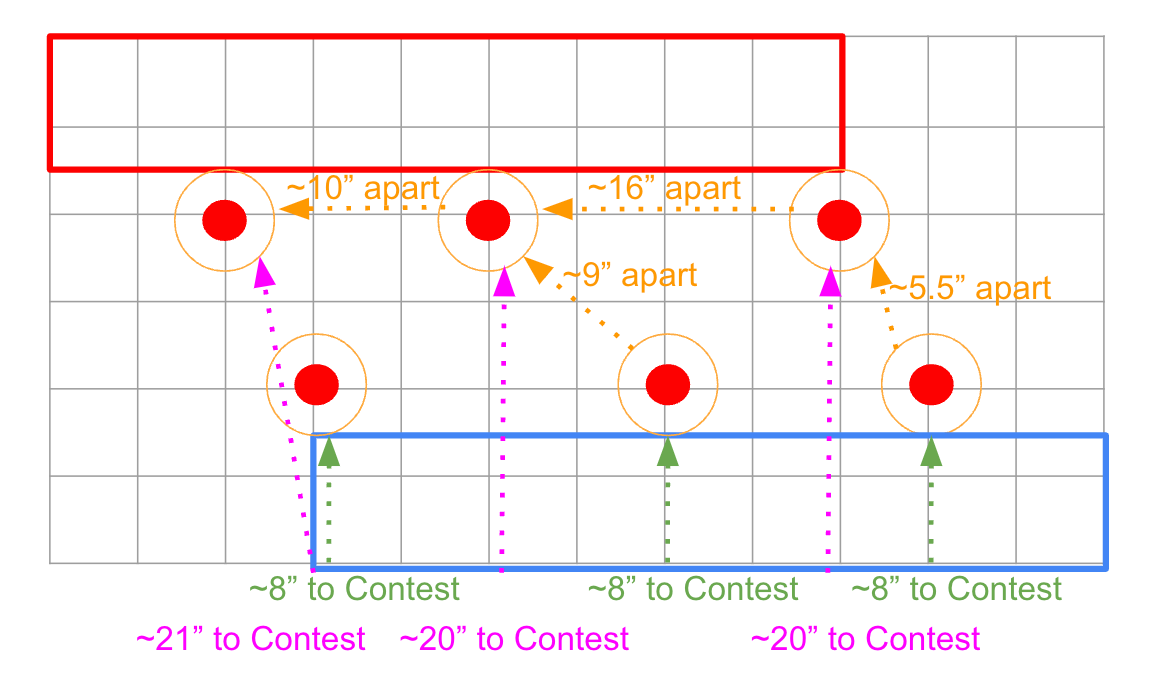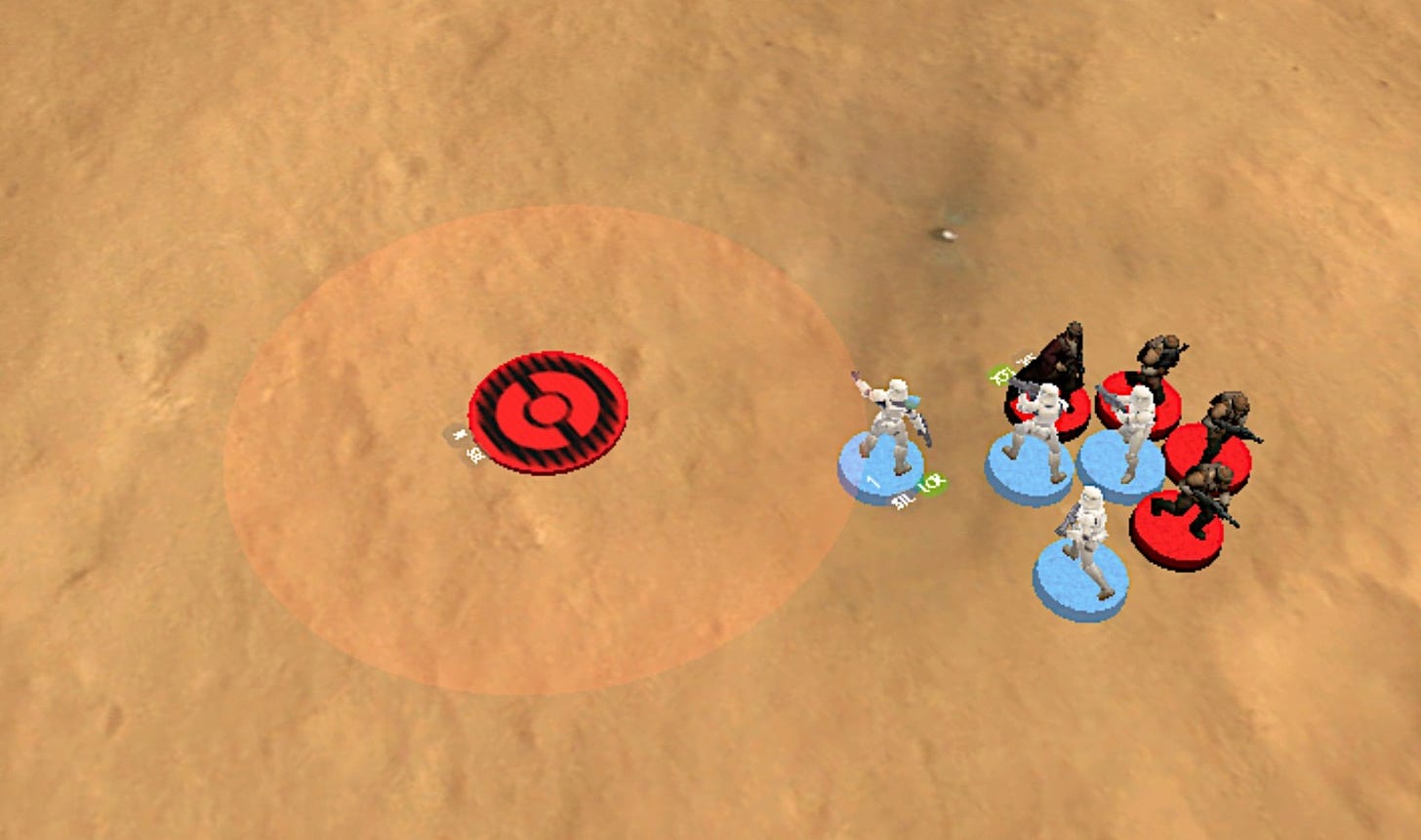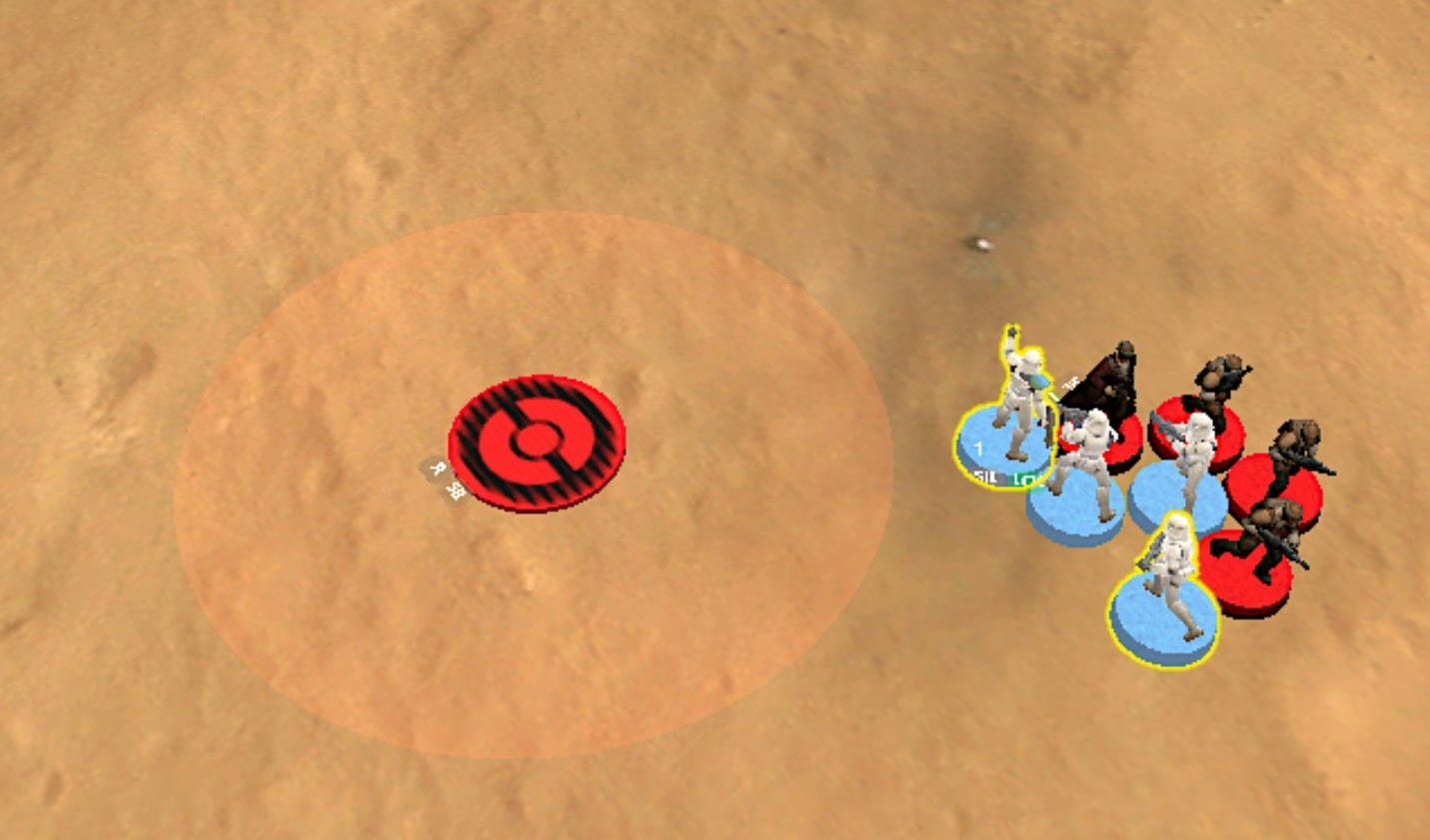Previous posts in the series: Turn Zero and Tempo; Deployment; Contesting, Securing, and Shifting Priorities
Welcome back to another post in our series on the new Objectives in Legion 260. Today we’ll be covering the Primary Objective Recover the Research. Like last week, we’ll start by laying out how the Objective works. Next, we’ll look at the map of friendly and contested territory and consider how far players will have to go to contest the Points of Interest. We’ll give an overview of the “baseline” Victory Points and what the tempo of scoring might look like, then end on what makes this objective unique.
Before we begin, I want to make sure we’re all familiar with a few ideas. First, the relation between ranges, moves, and actual distances. Each range band is 6.” Below you can see the distance a small-base trooper covers at each speed:
So, for example, a speed-two trooper can move up to the equivalent of range one. We did a deeper dive on this here.
Next, we’ve mentioned POI Bubbles in previous posts. To contest a POI, a unit must be at .5 range of it. This means that each POI has a 3” bubble surrounding it. To contest that POI, a unit much be touching that bubble.
Recover the Research
How It Works
Recover the Research is all about contesting Points of Interest. Players will aim to contest six different POIs (called labs in this objective). It’s important to emphasize that securing POIs has no benefit for Recover the Research. You only need to focus on having at least one unit leader at .5 range. Additionally, both players can potentially score the same POIs.
Starting in the End Phase of round two, players score a set number of VPs based on the number of POIs they are contesting. One VP for two POIs, two VPs for three POIs, and three VPs for four or more POIs.
The Map

There’s a lot going on here so we’ll break it down it down piece by piece. First, friendly territory is identical to Shifting Priorities with it covering all of their board edge apart from a range three chunk on a player’s left.
The POI’s are set in two rows at range two and four away from each player’s board edge. We’ll call the three nearer to their board edge the range two row and the three further the range four row. To contest a POI in the range two row, a unit has to move ~8” from its board edge (a single speed-two move only covers 6” so a speed-two units needs to move twice with no other effects). To contest a POI in the range four row, a unit would need to move ~20” from its board edge(that’s at least four speed-two moves).
I missed this on my first glance at release, but the POIs are not evenly divided in each row. The POIs nearest to a player’s board edge to the right and middle are roughly range three apart. The POIs to the left and middle are roughly range four apart. The orange arrows show the distance between each POIs bubble. We’ll talk about these more below.
Additionally, it is not possible to have a single commander’s courage bubble cover all three the POIs in a row. Similarly, only by contesting one of the central POIs, can a commander have four POI bubbles partially covered by their own courage bubble.
Baseline VPs
Since players can score VPs independent of one another, a lot of Recover games are going to score three VPs to three VPs in most rounds. Since a player only needs to have unit contesting four of the six POIs to score those three VPs, it can be difficult to stop your opponent from scoring the max each round. The normal back and forth between players duking it out to secure a POI (more unit leaders contesting it) doesn’t necessarily translate. In any given End Phase, a single unit contesting a POI scores just as well as ten units contesting that same POI.
To score the maximum three VPs per round, though, you will have to be contesting one of the range four row POIs (the ones closer to your opponent) each round. This can be especially tough round two. As we noted above, a unit has to move ~20” from its board edge to contest one of the far POIs. That would require a speed-two trooper unit to move with both actions during its first two activations (moving three of the four actions would only cover 18”). Even a speed-three trooper like a Mandalorian Super Commando would need to move three of its first four actions to end in contest range.
If, for whatever reason, you do not contest one of your range four POIs during round two, but your opponent does contest one of theirs, you open yourself to the possibility that you may never catch up.
Tempo
You may remember how last week we discussed having a game plan of tying or closely losing the Secondary Objective while winning the Primary Objective. In other words, planning to match the VPs your opponent could score via the Secondary Objective (Secondary VPs) while trying to exceed the amount they could score via the Primary (Primary VPs). This can be somewhat difficult in Recover. Again, both players can score the same POIs. This can often lead to rounds where both players contest four or more POIs and score three Primary VPs. Recover seems especially apt to tying on Primary VPs and being won on Secondary VPs or other VP effects like Bounty or Secret Mission.
The Secondary Objectives Recon Mission and Surface Scan can lead to some even weirder Recover games. These Secondaries consistently score one Secondary VP to each player in rounds two through five. Since, as we talked about, it’s not uncommon for rounds of Recover to tie three to three, this leads to Primary VP scoring like we see below:

For Recon Mission and Surface Scan, a player would reach twelve VPs in round four by contesting four POIs each round and scoring the single Secondary VP. In other words, each player could score twelve VPs by round four independent of the other player. Obviously, opponents have agency by defeating units, so this is not some foregone conclusion, but rather an example of how quickly close games of Recover can reach twelve VPs. In that example, the game would continue on if both players are tied at the end of a round, even if they have 12 or more VPs.
However, let’s dig into how someone might try to win Recover outright or how someone might try to swing the tempo back in their favor if they fall behind in Recover. Generally speaking, to pull ahead of your opponent in Recover, a player needs to force their opponent to not contest three or more POIs.
Let’s consider, then, how can you force a unit that is currently contesting a POI not to contest that POI:
Defeating a unit: a unit not on the table obviously cannot contest a POI
Panicking a unit: units that have double or more suppression than their courage value (or that of their commander at range three) do not contest POIs (note that suppression is removed after scoring in the End Phase in 260, not before)
Moving a unit: unit leaders beyond .5 range of a POI do not contest that POI
Though somewhat obvious, its important to be aware that these are the mechanisms available to you as a player. Sometimes, it will be significantly easier to panic a unit instead of defeating it. For scoring a POI on a given round, that panicked unit is no different than if it was defeated.
Let’s dig into point three specifically. Force Push is the obvious effect that moves an opponent’s unit leader. In almost every circumstance, the speed-one move from Force Push can take a unit leader that is contesting a POI out of the POI’s bubble. Any Command Card effect that allows you to move your opponent’s unit leader (think Vader’s Might or You Disappoint Me) will do the same in most circumstances (barring particularly unique terrains set ups).
However, more common than these effects which are often limited to expensive units, any unit with a melee weapon profile in the game has the potential to move an opponent’s unit leader. When such a unit moves into base contact with an enemy mini, the moving player first places the rest of the minis in its unit in base contact with minis from the enemy unit. Then, starting with the enemy unit leader, the enemy player places minis that are not yet in base contact with minis from the moving unit. This means that the player moving into melee can force the enemy unit leader to move by not putting any models into base contact with it. Here’s an example below:


Single model minis are especially benefitted by this change from the previous CRB (previously they couldn’t guarantee the unit leader would move if the enemy unit had five or more minis in it). We’ll have a full post going into ways this change can be used by Force Users in combination with other effects later this in this series.
In summary, to win more Primary VPs on Recover in a given round, you’ll need to force your opponent not to contest three or more POIs by either defeating units contesting those POIs, panicking units contesting those POIs, or moving units contesting those POIs.
What Makes Recover The Research Unique?
I’ll emphasize two things here. First, there is no need to secure POIs to win a game of Recover the Research. One unit contesting a POI is the same as three units contesting a POI during the End Phase.
Second, Recover the Research has the most POIs among the Primary Objectives. As we pointed out when discussing the map, it is impossible to have a courage bubble from a single commander cover all the POIs. Further, a commander actually contesting a POI can only cover two of the three POIs in a given row.
Wrap Up
Like always, we’ll end with some recommendations about lists that might take Recover the Research. This is by no means exhaustive. Rather, I hope to get your list-building juices flowing.
First, lists with one or more large base units like the AAT Trade Federation Battle Tank, NR-99 Persuader Class Tank Droid, TX-130 Saber Class Fighter Tank or the A-A5 Speeder Truck will often bring Recover the Research. Each of these units can contest both POIs to the right or left side (the ones 5.5” apart) at the same time. Since vehicles do not have a courage value, this means that your opponent would have to defeat that unit to keep you from scoring those two POIs alone. When playing against one of these units, it may be worthwhile to have some minis between those POIs. Since Displacement is gone from 260, the vehicle would have to defeat those minis to move to a spot to contest both POIs.
Rebel Bad Batch with Omega can contest two POIs as well though they do have a courage value to worry about.
Lists with only a few quick units will probably bring Recover the Research. By a few “quick” units, I mean a list that has some amount of Scout/Infiltrate/Transport or Speeders but may not have a ton of units like that. Having something that doesn’t need to perform four moves to contest a range four POI (like a speed-two trooper would without other effects) lets a player contest the four POIs needed to maximize scoring during round two. After round two, it is not particularly difficult for your speed-two units to contest those range four POIs.
Lists with lots of fast units still have some advantages, though. Other than the two POIs on each side, units will generally have to spend both actions to move from contesting one POI to another. Speeders or other particularly fast units can potentially move from contesting one POI to another and still have actions left in their activation.
High courage lists will do well at Recover the Research. This could mean multiple commanders, high courage commanders, lists with predominantly courage two troopers, or lots of vehicles. As we discussed above, panicking a unit can often be easier than defeating a unit, especially courage one troopers outside of command bubbles. Lists that don’t have to worry about this take away an option from their opponent.
Thanks for reading! Let me know what lists you’re bring Recover the Research with in the comments below. We have another Fun Stuff Friday coming later this week with some interviews from the first official Grand Tournament of Legion 260, the Salt Lake Open.





